Standard [CURRENT]
ASTM E 975:2022
Standard Test Method for X-Ray Determination of Retained Austenite in Steel with Near Random Crystallographic Orientation
- Publication date
- 2022
- Original language
- English
- Pages
- 7
- Note
- The publisher recommends this document in lieu of the withdrawn document ASTM E 975:2013 , for which no replacement is available.
- Publication date
- 2022
- Original language
- English
- Pages
- 7
- Note
- The publisher recommends this document in lieu of the withdrawn document ASTM E 975:2013 , for which no replacement is available.
- DOI
- https://dx.doi.org/10.1520/E0975-22
Product information on this site:
Quick delivery via download or delivery service
Buy securely with a credit card or pay upon receipt of invoice
All transactions are encrypted
Short description
1.1 This test method covers the determination of retained austenite phase in steel using integrated intensities (area under peak above background) of X-ray diffraction peaks using chromium K α or molybdenum K α X-radiation. 1.2 The method applies to carbon and alloy steels with near random crystallographic orientations of both ferrite and austenite phases. 1.3 This test method is valid for retained austenite contents from 1 % by volume and above. 1.4 If possible, X-ray diffraction peak interference from other crystalline phases such as carbides should be eliminated from the ferrite and austenite peak intensities. 1.5 Substantial alloy contents in steel cause some change in peak intensities which have not been considered in this method. Application of this method to steels with total alloy contents exceeding 15 weight % should be done with care. If necessary, the users can calculate the theoretical correction factors to account for changes in volume of the unit cells for austenite and ferrite resulting from variations in chemical composition. 1.6 Units- The values stated in inch-pound units are to be regarded as standard. The values given in parentheses are mathematical conversions to SI units that are provided for information only and are not considered standard. 1.7 This standard does not purport to address all of the safety concerns, if any, associated with its use. It is the responsibility of the user of this standard to establish appropriate safety, health, and environmental practices and determine the applicability of regulatory limitations prior to use. 1.8 This international standard was developed in accordance with internationally recognized principles on standardization established in the Decision on Principles for the Development of International Standards, Guides and Recommendations issued by the World Trade Organization Technical Barriers to Trade (TBT) Committee.
ICS
77.040.99,
77.080.20
DOI
https://dx.doi.org/10.1520/E0975-22
Also available in
Loading recommended items...
Loading recommended items...
Loading recommended items...
Loading recommended items...

